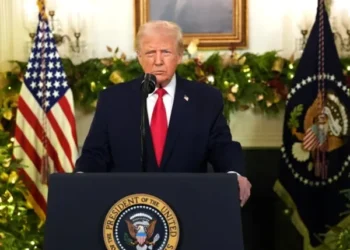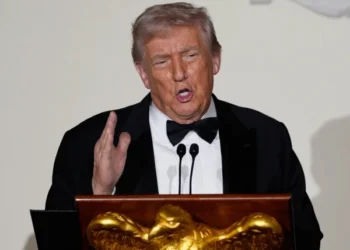Washington, D.C. – A Bold Economic Move
In a significant policy shift aimed at reshaping the US automotive industry, President Donald Trump has announced a 25% tariff on all imported cars and light trucks. The move, executed through an executive order, has drawn mixed reactions from both domestic manufacturers and international trade partners.
Speaking from the Oval Office, President Trump emphasized that the decision is designed to bolster domestic production, protect American jobs, and reduce the US trade deficit.
“We are going to impose a 25% tariff on all cars that are not made in the US,” Trump stated. “This is about securing our economic future and ensuring that American workers get the first priority when it comes to manufacturing and employment.”
The policy, set to take effect from April 3, is expected to have widespread implications for automakers, global trade relations, and consumer prices in the US.
Aims and Justifications for the Tariff
The Trump administration has justified the move by citing multiple economic and strategic factors:
- Boosting Domestic Production: The US auto industry has faced stiff competition from foreign automakers, particularly from countries like Japan, Germany, and South Korea. Trump’s tariff is seen as an effort to encourage companies to manufacture cars within the US, thereby creating jobs and strengthening the industrial base.
- Reducing the Trade Deficit: The US has a long-standing trade deficit with several nations, particularly China and European countries. By imposing tariffs, the administration aims to narrow this deficit and increase domestic revenue.
- Encouraging US Investment: The White House believes that imposing tariffs will incentivize automakers to invest more in American factories rather than outsourcing production to countries with lower labor costs.
- Compensating for Tax Cuts: The administration argues that increased revenue from tariffs can help offset tax cuts introduced during Trump’s presidency, ensuring a balanced economic approach.
Reactions from Global Leaders and Industry Experts
International Opposition
Trump’s decision has sparked strong criticism from major US trading partners. European Commission President Ursula von der Leyen labeled the measure as “harmful for businesses and worse for consumers,” indicating that retaliatory measures could be on the horizon.
In Canada, Prime Minister Mark Carney expressed his disappointment, calling the tariffs a “direct attack on Canadian workers.” Canada, home to major manufacturing hubs for companies like Ford and General Motors, is likely to face significant economic setbacks due to these tariffs.
Automakers’ Concerns
Leading automotive manufacturers, including Toyota, Volkswagen, and BMW, have raised concerns over the economic feasibility of these tariffs. Many global companies rely on an integrated supply chain, where parts and vehicles move freely across borders to keep costs low and production efficient.
The American Automotive Policy Council (AAPC), which represents US automakers such as General Motors, Ford, and Stellantis, has also warned that higher tariffs could lead to increased vehicle prices for consumers and potential retaliatory tariffs from other countries, affecting American exports.
Impact on Consumers and the US Economy
Higher Prices for Cars
Experts predict that the tariffs will inevitably lead to price increases for imported vehicles. According to industry analysts, a 25% increase in import costs could add thousands of dollars to the price of some foreign-manufactured cars, making them less competitive in the US market.
While the administration believes this will encourage more Americans to buy domestically produced cars, critics argue that limited choices and higher costs could negatively impact consumers, particularly those looking for affordable and fuel-efficient vehicles.
Effect on US-Based Foreign Manufacturers
Many foreign automakers have established production plants in the US, including Honda, Nissan, and Mercedes-Benz. While these companies may not be directly affected by the tariff, their reliance on imported parts could result in higher production costs, which may ultimately be passed on to consumers.
Potential Trade Wars and Retaliation
Trump’s tariffs could escalate tensions with key trading partners, leading to retaliatory tariffs against US exports. Countries affected by the move may respond with countermeasures, targeting US agricultural products, technology, and other industries, potentially harming American businesses reliant on exports.
Future Implications: What Comes Next?
The global automotive market is bracing for a period of uncertainty as stakeholders assess the long-term effects of these tariffs. While the US government remains firm in its stance, pressure from international allies, automakers, and consumers may lead to modifications in the policy over time.
Possible Negotiations and Adjustments
With major economies such as the European Union, Canada, and Japan pushing back against the tariff, diplomatic negotiations may take place in the coming months. If sufficient opposition arises, the administration could introduce exemptions or alternative policies to mitigate the economic impact.
Impact on US Elections
With elections on the horizon, the political ramifications of this decision could be significant. The tariffs may appeal to blue-collar voters in key industrial states, reinforcing Trump’s stance on economic nationalism. However, backlash from businesses and consumers affected by higher costs could also influence voter sentiment.
Conclusion: A Controversial Economic Gamble
Trump’s decision to impose a 25% tariff on imported cars marks a bold shift in US trade policy. While the administration sees it as a necessary step to boost domestic industry and reduce the trade deficit, critics warn of rising consumer costs, economic retaliation, and strained international relations.
As the policy takes effect, the automotive industry, global markets, and American consumers will closely watch its impact. Whether this move strengthens the US economy or leads to unintended consequences remains to be seen, but one thing is certain—the debate over tariffs and trade policy is far from over.

























